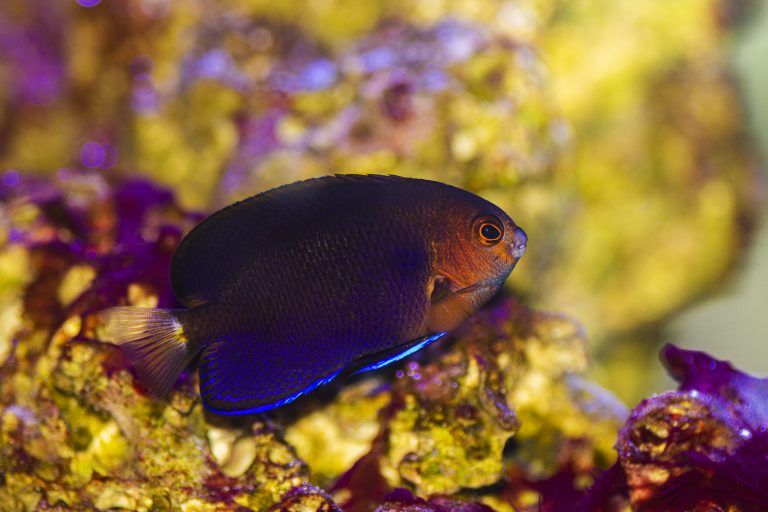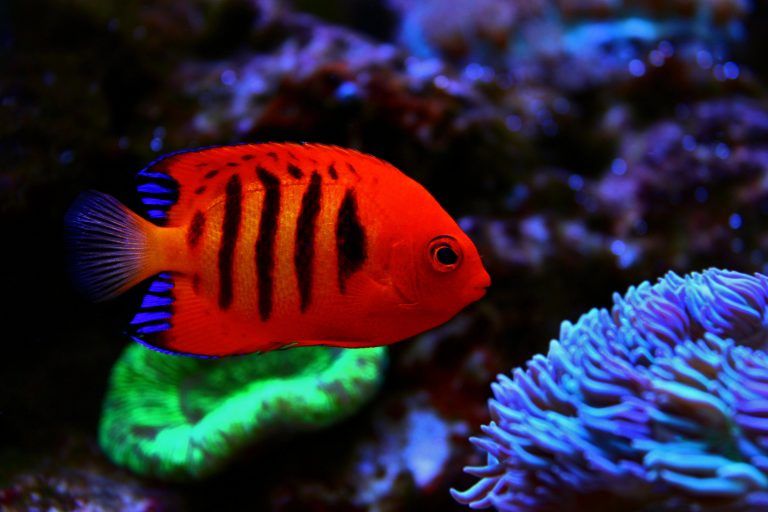The Bicolor Angelfish, also known as the Two-Colored Angelfish, is a striking marine fish renowned for its vibrant coloration. Sporting a bright yellow front half and a deep blue or purple rear, this dwarf angelfish is a visually stunning addition to reef and marine aquariums. Native to the Indo-Pacific region, Bicolor Angelfish are active, curious, and moderately hardy, making them popular among intermediate to advanced aquarists. This article will discuss the care requirements for Bicolor Angelfish.
Aquarium Requirements
Bicolor Angelfish require a well-established marine aquarium with plenty of hiding spots and live rock for grazing. Because of their active swimming behavior, a tank of at least 70 gallons (265 liters) is recommended for adults. Provide caves and crevices to reduce stress and mimic their natural coral reef environment. Bicolor Angels, like other angelfish species, love weaving in and out of rockwork while grazing and exploring. Strong water flow is beneficial, but avoid excessively turbulent currents.
Is the Bicolor Angelfish Reef Safe?
Bicolor Angelfish are semi-aggressive and not entirely reef safe. They may nip at corals, clams, and sessile invertebrates, especially as they mature. They are generally safe with large, well-established corals, but caution is advised if adding them to a sensitive reef tank. The risk is often not worth it if you have coral you love in your aquarium. Angelfish are hit or miss regarding being reef safe, so add these fish at your own risk.
Water Parameters
Maintaining stable and pristine water conditions is crucial for the health and longevity of Bicolor Angelfish. They are sensitive to sudden fluctuations in temperature, pH, and salinity, which can stress the fish and make them more susceptible to disease. Ideally, the aquarium should maintain a temperature range between 72 and 78°F (22–25.5°C), reflecting the warm tropical waters of their native Indo-Pacific habitat. Consistency is key, so using a reliable heater and monitoring devices is recommended to avoid sudden spikes or drops in temperature. If you’re shopping around for heaters, take a look at 6 Best Aquarium Heaters for Freshwater & Saltwater Fish Tanks.
The pH of the water should be kept slightly alkaline, around 8.1 to 8.4, which supports their physiological processes and overall well-being. Maintaining stable alkalinity and calcium levels is equally important, particularly if the tank contains corals or live rock. Salinity should mimic natural seawater, ideally falling between 1.020 and 1.025 specific gravity. Regular testing and adjustments are necessary, especially after water changes or top-offs, to prevent osmotic stress. There are many “Different Salinity Reading Tools for Saltwater Fish Tanks”. Decide which works best for you and keep your salinity levels in check.
Ammonia and nitrite levels must be kept at zero, as even trace amounts are toxic to marine life. Nitrate levels should be minimized, ideally below 20 ppm, through regular partial water changes and efficient biological filtration. Strong, healthy water circulation helps maintain oxygenation and distributes nutrients evenly, but excessive turbulence should be avoided to prevent the fish from becoming stressed. Overall, a stable, clean, and well-monitored aquatic environment is foundational to keeping Bicolor Angelfish healthy, vibrant, and active in captivity.
Food & Diet
Bicolor Angelfish are omnivorous grazers, meaning their diet in the wild consists of both plant matter and small animal protein. In captivity, replicating this variety is essential to maintain their vibrant coloration, overall health, and natural behavior. They have a strong preference for algae, which they continuously graze on throughout the day. Providing marine algae, such as nori or spirulina, helps satisfy this instinct and prevents nutritional deficiencies.
In addition to algae, Bicolor Angelfish thrive on a high-quality prepared diet formulated specifically for marine angelfish. These foods often contain essential vitamins, minerals, and pigments that enhance their vivid yellow and blue coloration. Supplementing their diet with protein-rich meaty foods, such as mysis shrimp, brine shrimp, and clams, supplies the protein necessary for growth, tissue repair, and reproductive health. To ensure optimal feeding, it is best to offer multiple small feedings throughout the day rather than a single large portion. This approach mimics their natural grazing behavior, reducing competition with tank mates.
Tank Mates
Selecting appropriate tank mates for the Bicolor Angelfish is important due to their semi-aggressive and territorial nature. In their natural reef habitats, these angelfish defend small areas while coexisting with other species. This behavior often carries over in captivity. They tend to assert dominance over similarly sized or more passive fish, so careful planning is required to minimize stress and aggression in a home aquarium.
Bicolor Angelfish are best housed with other robust, semi-aggressive species that can hold their own but are not overly aggressive themselves. Ideal companions include tangs, wrasses, and certain larger clownfish. These species are active swimmers that occupy different areas of the tank, reducing direct competition for territory. Conversely, small, timid, or slow-moving fish may become stressed or bullied if housed with a Bicolor Angelfish, so these should generally be avoided unless the aquarium is large and offers plenty of hiding spaces.
When adding a Bicolor Angelfish to a community tank, it is often recommended to introduce it after all other fish have established their territories. This approach helps reduce initial aggression, as the angelfish will settle into available niches rather than immediately challenging established inhabitants. In tanks with multiple angelfish, extra caution is needed, as conflicts can be severe, particularly among males or between similarly sized individuals. Providing abundant live rock, caves, and visual barriers can help mitigate territorial disputes by giving each fish defined spaces to claim.
Ultimately, the success of a Bicolor Angelfish in a community setting depends on tank size, population balance, and the compatibility of individual personalities. When carefully managed, they can coexist peacefully while displaying their vibrant colors and active, engaging behavior.
Breeding
Breeding Bicolor Angelfish in captivity is rare and challenging. They are protogynous hermaphrodites in the wild, meaning individuals can change sex from female to male. Successful spawning usually requires large, well-established tanks with stable conditions, and larval rearing is difficult due to their planktonic early stage.
Final Notes
The Bicolor Angelfish is a beautiful and dynamic addition to a marine aquarium, but it requires careful husbandry, a spacious tank, and attention to diet and water quality. While they are not entirely reef safe, experienced aquarists who provide plenty of live rock and hiding spots can enjoy their striking presence in a mixed-species setup. With proper care, they can live up to 10 years or more in captivity. It’s hard to beat the beautiful colorations of this fish, but make sure it is the right fish for your aquarium before picking one up.
Thanks for clicking this tab, this is planned for a future feature of this website!




